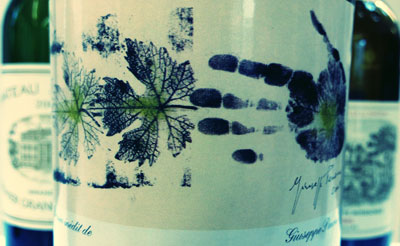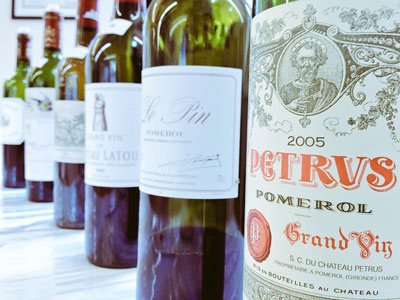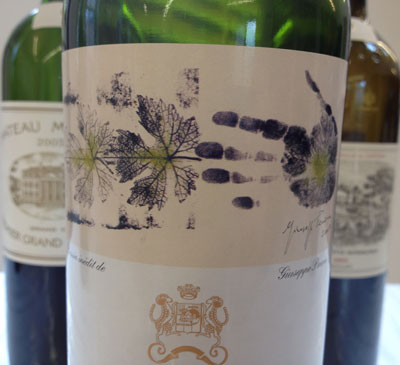2005 claret in 2015
(by Peter Richards MW)
 There is a risk, as you grow older, of donning the rose-tinted spectacles when considering the past.
There is a risk, as you grow older, of donning the rose-tinted spectacles when considering the past.
Take 2005. The last year of official service on the London streets for the proper old-school Routemaster bus (cue howls of forsaken nostalgia). And also, some might say, the last year of a truly great vintage in Bordeaux, when classic values weren’t abandoned in the rush to flashy modernism.
It was fascinating to taste through a line-up of 70 top-quality clarets from the 2005 vintage just a few months after tasting a similarly large and stellar range of the 2010s (which you can read about via this link).
The 2010 is championed as a top vintage. But I found notable variability. These days, warm dry weather doesn’t guarantee great wines in Bordeaux. Great wines balance complexity with drinkability. If producers choose to harvest over-ripe and make monsters of wines, the results are impressive – but not easy to drink. To be refreshing is wine’s first duty.
The 2005 claret vintage, by contrast, has the true air of greatness about it.
This is because the style of the wines naturally major on what Bordeaux does best: structure and scent. These are proper, grown-up red wines, with firm tannin, fresh acidity and a true sense of profundity and grab-you-by-the-lapels urgency. They are ageing gracefully and should continue to do so for some time to come.
Does this make me sound like a dinosaur pining for the good old days? Maybe I’m old before my time (my friends might agree). But there’s nothing rose-tinted about wanting wine to be refreshing, balanced and food-friendly. It’s what wine should be – claret above all. And the 2005 vintage in Bordeaux – while certainly not cheap, neither is it as over-priced as the 2009s or 2010s – is absolutely in that idiom.
So congratulations to those producers who made outstanding wine. And also, perhaps more so, to those who offer brilliant value in the context (Clerc Milon, d’Armailhac, du Tertre, Domaine de Chevalier, Langoa Barton, Poujeaux). This is a vintage for the drinking. Cheers to that.
(And thanks to Bordeaux Index for putting on the tasting.)
The 2005 claret brief
- A long, warm, dry vintage that gave a decent yield of healthy grapes with naturally thick skins. Dangers are over-extraction and dryness or unripe green notes from vines whose maturation was blocked by the drought.
- Fresh acidity and firm tannin are the hallmarks of this vintage.
- The very best wines weave harmony, complexity, scent and great length into this firm, classic structure. These top wines manage to be complex but also utterly refreshing and cleansing. A rare feat.
- As a set, the Left Bank wines are clearly superior to the Right Bank. While there are some very good wines from the latter, far too many wines are over-extracted, drying and alcoholic.
- Pauillac is the stand-out commune. Some notable variability in St Julien and St Estephe (also Margaux and Graves, but you expect it of these). Common faults are greenness or over-extraction. Many wines I’d normally expect to see hitting the high notes just didn’t perform in these areas.
- The top wines still need time to hit their peak. There is a classic structure to these wines that some might find off-putting but it bodes well for the future and for lovers of a classic Bordeaux style.
Tasting notes
- NB: prices quoted are those supplied by Bordeaux Index and are approximate prices, in bond, subject to availability
- These are the 30-odd most notable of the 70 wines in the tasting
Château Mouton-Rothschild 2005, Pauillac 13% (9.5/10, PR, 29.1.2015) (£4,650) – the price would suggest it’s considered the lesser of the first growths but I think this is currently the stand-out wine among them (so a bargain in some peoples’ world). Wonderfully open and beguiling aromas of tobacco, warm earth and dark chocolate. Cassis and leathery notes. The flavour profile is majestic. It manages to be both refreshing and grounded but also opulent and tremendously complex. A symphony. Great poise and balance. Stunning.
 Château Lafite Rothschild 2005, Pauillac 13% (9/10, PR, 29.1.2015) (£6,000) – still very young, not giving away much, but with a real sense of latent power and potential. Hints of wood smoke, warm earth and fine cassis fruit. Structurally, it’s pretty complete and very harmonious. Cogent, fine, firm – delicate for claret but insistent. Despite its reticence it’s hard not to be drawn in and sense great things for this wine.
Château Lafite Rothschild 2005, Pauillac 13% (9/10, PR, 29.1.2015) (£6,000) – still very young, not giving away much, but with a real sense of latent power and potential. Hints of wood smoke, warm earth and fine cassis fruit. Structurally, it’s pretty complete and very harmonious. Cogent, fine, firm – delicate for claret but insistent. Despite its reticence it’s hard not to be drawn in and sense great things for this wine.
Château Margaux 2005, Margaux 13% (9/10, PR, 29.1.2015) (£5,400) – that piercing smoky toasty floral aroma that is so typical of Margaux shoots out of the glass. Warm gravel and cassis accompany it. The palate is the epitome of claret minerality: cleansing, refreshing, fine, almost elemental in its insistence, perfume and sinewy lines. Beautiful claret, still young. Resonant.
Château Petrus 2005, Pomerol, 13.5% (8.5-9/10, PR, 29.1.2015) (£23,500) – a craggy, poised style that is uncompromising, slightly wild but you sense will just get more interesting as time passes. Aromas of fresh leather, honeycomb and a touch of tea leaf. Tons of fine firm tannins on the palate, really grippy and thrilling. Made for the long-run. Speaks in a gravelly baritone. Some porty notes but very dry, intense, earthy and serious. Needs another 10 years to start to show itself. I’m not naturally a big fan of Petrus but in this wine you start to discern the beauty of the beast.
Château Le Pin 2005, Pomerol 13% (8.5/10, PR, 29.1.2015) (£18,000) – a direct contrast to the Petrus, this is sappy, leafy and sprightly. Still pretty young. The palate is more impressive than the nose at this stage, with a fine vigorous feel and a sense of poise and precision. Insistent. Mineral, fine, firm, leafy, sappy. Bit of an enigma still but this could be seriously good.
Château Pontet Canet 2005, Pauillac 13% (8-8.5/10, PR, 29.1.2015) (£1,055) – inside this absurdly heavy bottle is a quite delicious 2005 claret. Showing very well, with really dramatic aromas of warm gravel and dried cassis. It’s textured, rich and succulent, with lovely fresh acidity and a cleansing finish. Wears its complexity lightly. Savoury and profound. Fabulous.
Château Latour 2005, Pauillac 13% (8/10, PR, 29.1.2015) (£6,360) – a solid, foursquare rendition of Latour. Dynamic, cleansing, spicy and gravelly. But it lacks a certain magic. A bit closed and hermetic, perhaps. While it may emerge, at the moment it shows a bit burly and obvious (especially when tasted after Lafite, which perhaps isn’t the most fortunate order for the Latour).
Château Lynch Bages 2005, Pauillac (8/10, PR, 29.1.2015) (£1,090) – one from the old school: benchmark stuff, elegant and beautiful for not trying too hard. Fine tannin, fresh acidity, layered flavours of roasted cassis and wood smoke. Really engaging and persistent. Beautiful Pauillac. One of the stars of the vintage.
Château Clerc Milon 2005, Pauillac 13% (7.5-8, PR, 29.1.2015) (£570) – the Mouton stable clearly out-performed in this vintage (see also d’Armailhac and Petit Mouton). Great value here, as this is a brilliant wine, bursting with aroma and flavour but also championing a classic, savoury, elegant and profound flavour profile. Tobacco, cassis, smoke, leather: it’s all here. Delicious.
Château Cheval Blanc 2005, St Emilion 14% (7.5/10, PR, 29.1.2015) (£4,100) – a very elegant and sensitively constructed wine. Engaging aromas of dried flowers, tobacco and blackcurrant lead into a flavour profile that’s juicy, fine-textured and nicely persistent. Gravelly, starting to unfurl, lots of potential here.
Château Léoville Poyferré 2005, St Julien 13.5% (7.5/10, PR, 29.1.2015) (£750) – a bit scattergun in its slightly wild complexity and volatile nature. But it’s engaging nonetheless, and certainly complex, with notes of cedar, tobacco and roasted fruit. Savoury style, tons of energy and fine texture, just not the most harmonious or lucid. Good, though.
Château Montrose 2005, St Estephe 13% (7.5/10, PR, 29.1.2015) (£970) – tons of very fine tannin but it’s not overdone within this style. Vigorous, muscular and masculine. Pretty forceful stuff. But fine textured, juicy and spicy too. Dark and fairly inscrutable, this still needs plenty of time yet. It shows up its St Estephe stable mates Calon Segur and Cos d’Estournel, whose fruit has fallen away and the tannins are too prominent as a result.
Château Smith Haut Lafitte 2005, Pessac-Leognan 13.5% (7.5/10, PR, 29.1.2015) (£850) – not for everyone but it’s pretty beguiling stuff. Vigorous, fine and spicy. Almost verges on austerity, it feels young still. Meaty overtones and a smoky, dark-fruited character. Fine, spicy, cleansing. Leave it for a good few years before opening.
Château Léoville Barton 2005, St Julien 13% (7-7.5/10, PR, 29.1.2015) (£700) – oh but this is a suave and debonair wine. Glossy, silky. Oozes charm. Does it lack profundity for it? Not really, I think this has more to give. Plenty of dark fruit and creamy concentration here. Give it time.
 Petit Mouton 2005, Pauillac 13% (7-7.5/10, PR, 29.1.2015) (£810) – another solid showing from the Mouton portfolio. OK, so it’s a bit feral (bretty) but it’s juicy and savoury and really engaging. Plump and come-hither. Lovely drinking claret.
Petit Mouton 2005, Pauillac 13% (7-7.5/10, PR, 29.1.2015) (£810) – another solid showing from the Mouton portfolio. OK, so it’s a bit feral (bretty) but it’s juicy and savoury and really engaging. Plump and come-hither. Lovely drinking claret.
Château Ausone 2005, St Emilion 14% (7/10, PR, 29.1.2015) (£11,200) – a correct wine that doesn’t light any fires for me. It may yet come into its own but for now the juicy, broad style with firm tannin is classic but lacks that all-important wow factor. Aromas of creamy candle wax and high-toned fruit.
Château d’Armailhac 2005, Pauillac 13% (7/10, PR, 29.1.2015) (£420) – one of the bargains of the bunch. It’s not for everyone, mind. It’s on the green end of the spectrum, with aromas of roasted green pepper, tea leaf and dried grass. But the palate is rounded and the tannins ripe. It’s juicy, spicy and savoury, pretty energetic stuff. Maybe lacks a touch of gravitas but at least it’s drinkable and engaging.
Château du Tertre 2005, Margaux 13% (7/10, PR, 29.1.2015) (£320) – surely one of the bargains of the vintage. If you like old school claret, that is. This is sprightly and nimble, with pure lines and made in a fundamentally refreshing, direct style. No fruit bomb this. Almost Burgundian aromas of sappy, leafy red fruits. Invigorating acidity, fine tannin and a long, linear finish. Tangy stuff that’s developing nicely.
Château Figeac 2005, St Emilion 13.5% (7/10, PR, 29.1.2015) (£950) – sinewy and lithe, this is a classy little number. Creamy, plummy character and gravelly hints. It’s elegantly constructed and will benefit from further time in bottle.
Château Haut-Brion 2005, Pessac-Leognan 14% en magnum (7/10, PR, 29.1.2015) (£4,660) – suffers from the affliction of many a Graves in the sense of a curiously hollow flavour profile. It’s creamy, expansive and with plenty of fine tannin – quite attractive in a way – but also too spicy, hot and rasping to be great.
Château La Conseillante 2005, Pomerol 13.5% (7/10, PR, 29.1.2015) (£1,440) – it’s quite a big, corpulent style but it’s effortlessly engaging at the same time. Well grounded, with nice fresh acidity, a fine texture and supple fruit character. Juicy, creamy, plummy and friendly.
Château Lascombes 2005, Margaux 13.5% (7/10, PR, 29.1.2015) (£750) – again, decent value here. Really elegant style – perfumed and zippy, maybe a tad austere but really lively and gravelly. Aromas of pencil shavings and tobacco, with a toasty note. Fresh acidity and firm fine tannin on the palate, not a heavy weight but very persistent and foodie.
Les Forts de Latour 2005, Pauillac 13% (7/10, PR, 29.1.2015) (£1,450) – pretty textbook stuff: cassis, cream, earthy aromas with a firm, fine flavour profile. It’s savoury and mineral, maybe a bit austere and correct, a little joyless perhaps. But it’s fine and with plenty to give too.
Château Pavie 2005, St Emilion 14.5% (7/10, PR, 29.1.2015) (£2,350) – slightly surprising result, this one. I couldn’t help but like it, in all its garish, OTT charm. Tons of ripe fruit and creamy oak, garlanded by tons of fine tannin: it’s polished and garrulous but is sufficiently grounded not to lapse into the absurd. Not my personal favourite but plenty of people will love this style.
Château Trotanoy 2005, Pomerol 13.5% (7/10, PR, 29.1.2015) (£1,700) – pretty high octane stuff but it seems to work, somehow. Big plummy fruit character backed up fine lots of wine tannin.
Domaine de Chevalier 2005, Pessac-Leognan 13% (7-6.5/10, PR, 29.1.2015) (£500) – decent value as ever from this estate. But it’s a fairly loose-knit rendition – easy-going and perfectly pleasant, very accessible. But not particularly profound. Glossy plummy fruit with a creamy texture. Broad and supple.
Château La Lagune 2005, Ludon 13% (7-6.5/10, PR, 29.1.2015) (£550) – lots to like here, albeit on a more modest register than some of the wines above. Quite wild, animalistic aromas. Earthy, leathery cassis and cedar. The palate is complex and fairly serious but lacks the real sturdy structure and core concentration to be great. Engaging, though.
Château Beychevelle 2005, St Julien 13% (6.5-7, PR, 29.1.2015) (£880) – pretty decent stuff. Slightly bloody in nature: earthy, juicy and savoury, almost with a saline edge to it. Fine textured.
Château Langoa Barton 2005, St Julien 13% (6.5-7, PR, 29.1.2015) (£450) – great value offering. Maybe lacks a bit of core concentration, and isn’t the most thrilling style, but there’s lots to like here, especially at the price. Dusty fruit and smoky tones on the nose, with a grippy, fine, juicy flavour profile.
Château Poujeaux 2005, Moulis 13.5% (6.5-7/10, PR, 29.1.2015) (£280) – certainly a great value buy. Where some wines at this level simply lack weight and drinking pleasure, this Poujeaux is drinking really well. Fine, firm, savoury and energetic. Pretty persistent too.
Château La Mission Haut-Brion 2005, Pessac-Leognan 14.5% (6.5/10, PR, 29.1.2015) (£3,650) – big, plummy, toffee and broad. Hot. Some may like this style but it lacks gravitas and drinkability.
